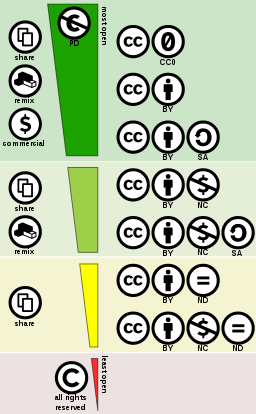2 Introduction to Open Licensing
Learning Objectives
This chapter will support learners in being able to:
- Define an open license
- Distinguish between materials that are all rights reserved, in the public domain, and openly licensed
- Identify the four factors of fair use
What is Copyright?
Copyright is a form of legal protection automatically provided to the authors of “original works of authorship,” including literary, dramatic, musical, and artistic works. Copyright in the U.S. is automatically assigned to creators of work, with no registration necessary.
It can be unlawful to use copyrighted works of others without their permission, and no permissions are granted in the case of All Rights Reserved (ARR) works. Activities such as copying, modifying, publicly displaying, publicly performing, and distributing copies of ARR work may be illegal unless permission is granted by the creator. U.S. copyright law generally gives the author/creator or owner of an original creative work an exclusive right to
- Reproduce (copy) or distribute the original work to the public (e.g., create and sell copies of a film)
- Create new works based upon the original work (e.g., make a movie based on a book)
- Perform or display the work publicly (e.g., perform a play)
Violation of one of these rights is called copyright infringement. However, the use may be authorized by copyright limitations (such as fair use) described below.
What is Fair Use?
Start with an overview of fair use by viewing this short video:
Fair use is a copyright principle based on the belief that the public is entitled to freely use portions of copyrighted materials for purposes of commentary and criticism. Whether or not a specific use falls under Fair Use is determined by four factors:
- the purpose and character of your use
- the nature of the copyrighted work
- the amount and substantiality of the portion taken, and
- the effect of the use upon the potential market
Unfortunately, if the copyright owner disagrees with your fair use interpretation, the dispute may have to be resolved by a lawsuit or arbitration. If it’s not a fair use, then you are infringing upon the rights of the copyright owner and you may be putting yourself or the institution at risk. The only guidance for fair use is provided by a set of factors outlined in copyright law. These factors are weighed in each case to determine whether a use qualifies as a fair use.
Recognizing the differences between how copyrighted material and openly licensed or public domain material can be reused and shared legally, allows for a comprehensive understanding of the Fair Use principle.
Additional information on Fair Use and the TEACH Act can be found at the University of Texas Libraries – Crash Course on Copyright website.
Understanding an Open License
In the previous chapter, you learned that an open educational resource is either in the public domain or released with copyright permissions which allows for free use and repurposing by others. Specifically, an open license exists as a way for the original creator to clearly inform others how their work can be used by granting permissions to share and adapt their work. A Public Domain license and the variety of open license permissions known as Creative Commons (CC) are the predominant standards for open licenses. You will learn more about the six different CC license permissions in Chapter 10.
This video, What Is An Open License and How Does it Work?, provides more information about the benefits of an open license and how this standard makes sharing and reusing resources easy.
What do the licenses mean?
It is the copyright status and license applied to a work which determine what you can and cannot do with the creative work of someone else. Knowing how to identify and differentiate between common types of copyright status will be useful when determining which content you may reuse, and how. One should assume that a work is all rights reserved, unless the creator explicitly states otherwise or the user of the work can prove it differently.
As you search for OER, you will become familiar with the markings of each license type.

Click on each license code below to learn more about it.
Attribution: CC BY 
Attribution-ShareAlike: CC BY-SA 
Attribution-NoDerivs: CC BY-ND 
Attribution-NonCommercial: CC BY-NC 
Attribution-NonCommercial-ShareAlike: CC BY-NC-SA 
Attribution-NonCommercial-NoDerivs: CC BY-NC-ND 
You can find lots more information about open licensing and Creative Commons in Part Two of this book, While You’re Waiting.
This license lets others distribute, remix, tweak, and build upon your work, even commercially, as long as they credit you for the original creation. This is the most accommodating of licenses offered. Recommended for maximum dissemination and use of licensed materials.
This license lets others remix, tweak, and build upon your work even for commercial purposes, as long as they credit you and license their new creations under the identical terms. This license is often compared to “copyleft” free and open source software licenses. All new works based on yours will carry the same license, so any derivatives will also allow commercial use. This is the license used by Wikipedia, and is recommended for materials that would benefit from incorporating content from Wikipedia and similarly licensed projects.
This license allows for redistribution, commercial and non-commercial, as long as it is passed along unchanged and in whole, with credit to you.
This license lets others remix, tweak, and build upon your work non-commercially, and although their new works must also acknowledge you and be non-commercial, they don’t have to license their derivative works on the same terms.
This license lets others remix, tweak, and build upon your work non-commercially, as long as they credit you and license their new creations under the identical terms.
This license is the most restrictive of our six main licenses, only allowing others to download your works and share them with others as long as they credit you, but they can’t change them in any way or use them commercially.

